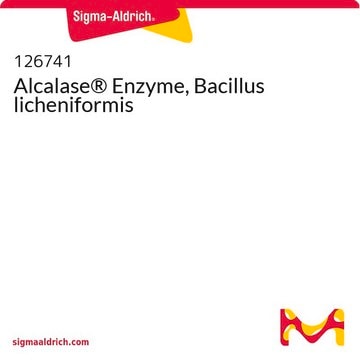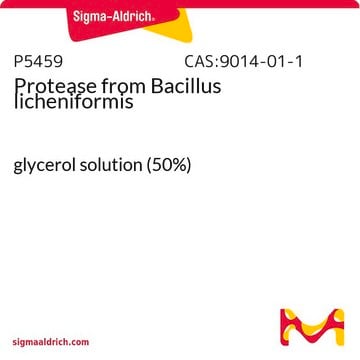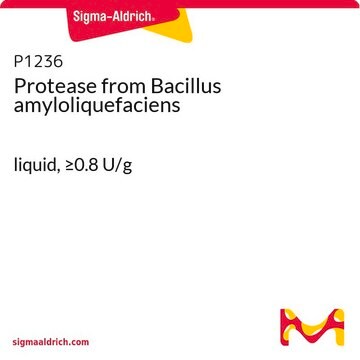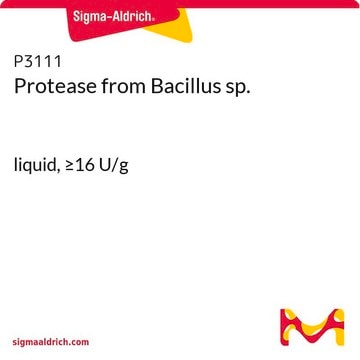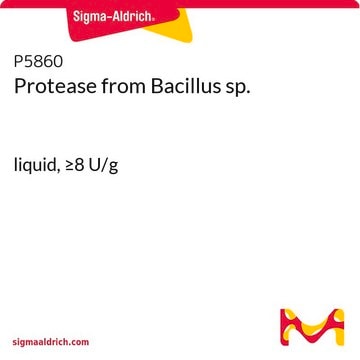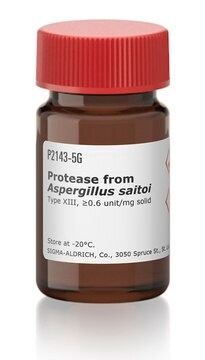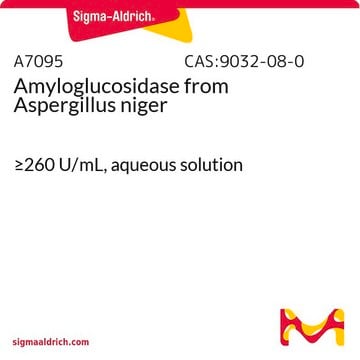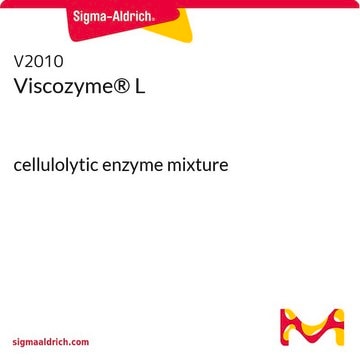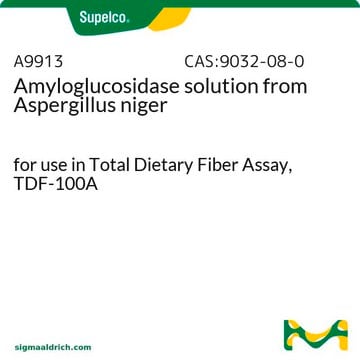This product is intended for research use only and is not suitable for human or veterinary use. Currently, a food grade product is not available.
P4860
Protease from Bacillus licheniformis
≥2.4 U/g
Synonym(s):
Alcalase® 2.4L, Proteinase from Bacillus licheniformis, Subtilisin A
About This Item
Recommended Products
form
aqueous solution
specific activity
≥2.4 U/g
storage temp.
2-8°C
Looking for similar products? Visit Product Comparison Guide
Related Categories
General description
Application
Biochem/physiol Actions
Analysis Note
Legal Information
Signal Word
Danger
Hazard Statements
Precautionary Statements
Hazard Classifications
Aquatic Acute 1 - Aquatic Chronic 2 - Eye Dam. 1 - Resp. Sens. 1 - Skin Irrit. 2 - STOT SE 3
Target Organs
Respiratory system
Storage Class Code
10 - Combustible liquids
WGK
WGK 2
Personal Protective Equipment
Choose from one of the most recent versions:
Certificates of Analysis (COA)
Don't see the Right Version?
If you require a particular version, you can look up a specific certificate by the Lot or Batch number.
Already Own This Product?
Find documentation for the products that you have recently purchased in the Document Library.
Customers Also Viewed
-
Is this a food grade product?
1 answer-
Helpful?
-
-
What is the density of the P4860 enzyme?
1 answer-
This item is a product of Novozymes Corp. The supplier reports a density of 1.17g/ml at 20 degrees C.
Helpful?
-
-
What is optimal temperature and ph for this enzyme?
1 answer-
According to the manufacturer’s (Novozymes Corp.) Product Sheet, by analyzing Alcalase at various pH values using a modified Anson/haemoglobin method, its optimum activity has been found to be at pH between 6.5 and 8.5; its temperature optimum is around 60°C, but could vary between 55°C and 70°C, depending on the type of substrate.
Helpful?
-
-
How many mg of enzyme/mL of solution are there?
1 answer-
The density of the solution is 1.17 g/mL at 20 °C.
Helpful?
-
-
Can this be used for production of fish protein hudrolysate? Also what is the difference between this enzymeand Alcalse 2.4l?
1 answer-
This product is identical to Alcalase 2.4L. This material has not been tested for use in fish. A search of the literature shows a number of publications related to the use of this enzyme in animal protein production. However, a specific reference for use in fish was not found. Please see the links below to review articles that may be of interest:
Chicken meat
https://ift.onlinelibrary.wiley.com/doi/10.1111/j.1750-3841.2008.00765.xFish scales
https://www.ncbi.nlm.nih.gov/pmc/articles/PMC8063752/Helpful?
-
-
What is the extinction coefficient?
1 answer-
The extinction coefficient is not determined for this product.
Helpful?
-
-
What is the extinction coefficient for this enzyme?
1 answer-
The extinction coefficient for this enzyme is not determined.
Helpful?
-
-
What is the molecular weight?
1 answer-
The molecular weight of Protease from Bacillus licheniformis (Product No. P4860) is approximately 27 kDa.
Helpful?
-
-
What is the optimal pH for the use of enzyme P4860?
1 answer-
According to the manufacturer Novozyme, the optimal pH for the use of product P4860 is approximately pH 9.
Helpful?
-
-
What is the concentration of the product, and how can the conversion from units/g on the COA to units/ml be performed?
1 answer-
The density of the Novozymes product, as indicated in the SDS sheet, is 1.17g/ml. By multiplying 1.17 g/ml (density) by 50 ml (pack size), 58.5 g of the solution is obtained. Further multiplication with 2.55 unit/g (lot activity) results in 149.175 or 149.2 units. Dividing 149.2 units by 50ml gives 2.984 units/ml.
Helpful?
-
Active Filters
Our team of scientists has experience in all areas of research including Life Science, Material Science, Chemical Synthesis, Chromatography, Analytical and many others.
Contact Technical Service

